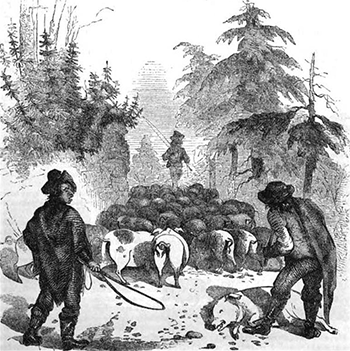Drovers
by Ruth Y. Wetmore, 2006
 Drovers were individuals who oversaw the movement of livestock herds from one place to another. From the early 1800s until railroads reached the mountains in the 1880s, livestock droves were a major industry in North Carolina. The chief thoroughfare for moving livestock from eastern Tennessee and western North Carolina to markets in South Carolina followed the French Broad River eastward to Asheville and then south. Overseen by drovers, livestock such as hogs, cattle, mules, horses, and poultry (primarily turkeys) traveled "on the hoof" for 8 to 10 miles per day on what was often a 200-mile journey. Droves were usually made from October to December. A series of toll roads, such as the Buncombe Turnpike from Greenville, Tenn., to Asheville and the Little River Turnpike, which ran southward from Mills River, were built and maintained locally by revenues from toll gates at 10- or 15-mile intervals. "Stands," taverns or inns along the way, provided food and shelter. Stand proprietors were also merchants, selling goods to local farmers in return for corn at harvest time and taking payment from drovers in the form of lame animals or cash after the herds were sold.
Drovers were individuals who oversaw the movement of livestock herds from one place to another. From the early 1800s until railroads reached the mountains in the 1880s, livestock droves were a major industry in North Carolina. The chief thoroughfare for moving livestock from eastern Tennessee and western North Carolina to markets in South Carolina followed the French Broad River eastward to Asheville and then south. Overseen by drovers, livestock such as hogs, cattle, mules, horses, and poultry (primarily turkeys) traveled "on the hoof" for 8 to 10 miles per day on what was often a 200-mile journey. Droves were usually made from October to December. A series of toll roads, such as the Buncombe Turnpike from Greenville, Tenn., to Asheville and the Little River Turnpike, which ran southward from Mills River, were built and maintained locally by revenues from toll gates at 10- or 15-mile intervals. "Stands," taverns or inns along the way, provided food and shelter. Stand proprietors were also merchants, selling goods to local farmers in return for corn at harvest time and taking payment from drovers in the form of lame animals or cash after the herds were sold.
References:
Wilma Dykeman, The French Broad (1955).
Foster Sondley, A History of Buncombe County, North Carolina (2 vols., 1930).
Additional Resources:
Ray, James M. "Reminiscences of 40 Years Ago." The Lyceum [Asheville, N.C.] 1. No 7. December 1890. p.15-20- https://digital.ncdcr.gov/Documents/Detail/lyceum-1890-december-v.1-no.7/501906?item=631361 (accessed August 29, 2012).
Sakowski, Carolyn. "Tour of the Month: Hot Springs." Touring Backroads (blog). November 11, 2011. http://touringbackroads.com/journal/tour-of-the-month-hot-springs (accessed August 29, 2012).
"An Act to prevent the Inhabitants of South Carolina driving their Stocks of Cattle from thence to range and feed in this Province, and other Purposes." Complete revisal of all the acts of Assembly, of the province of North-Carolina, now in force and use. New Bern [N.C.]: James Davis. 1773. p. 353-355. https://digital.ncdcr.gov/Documents/Detail/public-laws-and-resolutions-of-the-state-of-north-carolina-passed-by-the-general-assembly-at-its-session-of-...1893/1956314?item=21301878203 (accessed August 29, 2012).
"AN ACT to increase the Revenue of the State: Section 8: Taxes drovers of horses, mules or hogs, $5 in each county." Laws of the State of North Carolina, passed by the General Assembly at the Session of 1848-'49. Raleigh [N.C.]: Thomas J. LeMay, Star Office. 1849. p.132. https://digital.ncdcr.gov/Documents/Detail/laws-of-the-state-of-north-carolina-passed-by-the-general-assembly-1848-1849/1952519?item=2031314 (accessed August 29, 2012).
Image Credits:
"Hog Drovers." Harper's New Monthly Magazine XV. June to November 1857. New York: Harper & Brothers. p. 595. http://books.google.com/books?id=1ikZAAAAYAAJ&ots=Y6ABpUMrRK&dq=Harper's Magazine volume 15 1857&pg=PA595#v=onepage&q&f=false (accessed August 29, 2012).
1 January 2006 | Wetmore, Ruth Y.